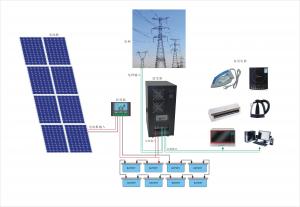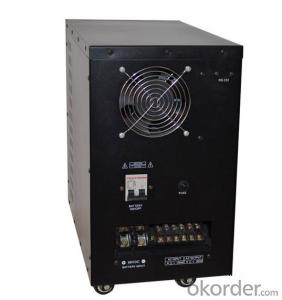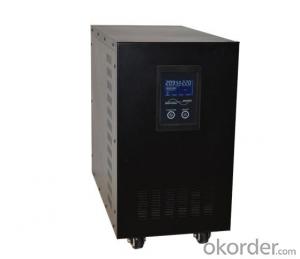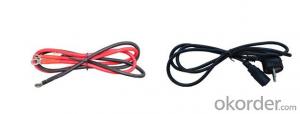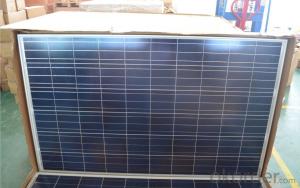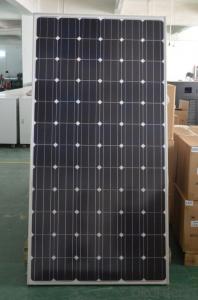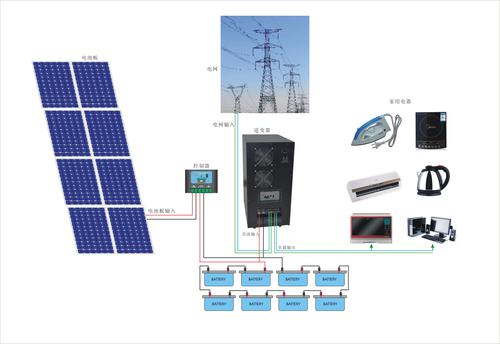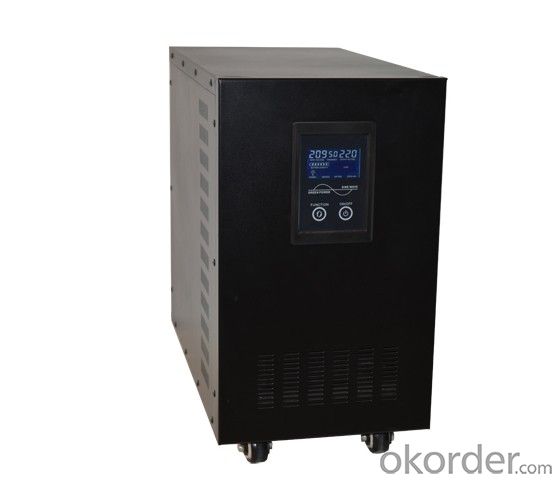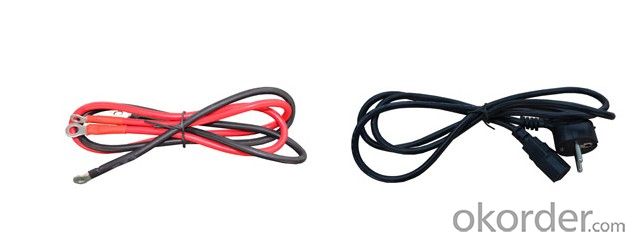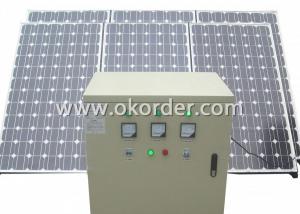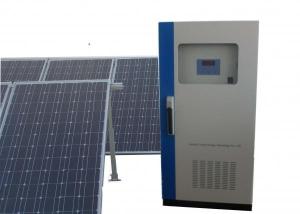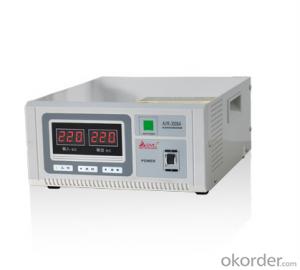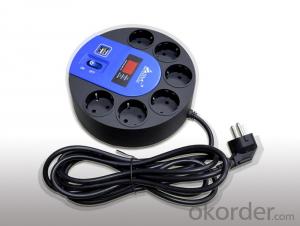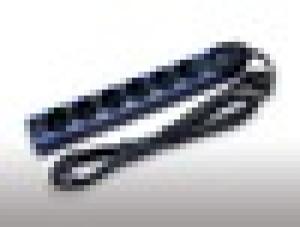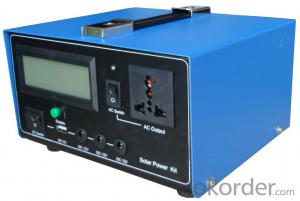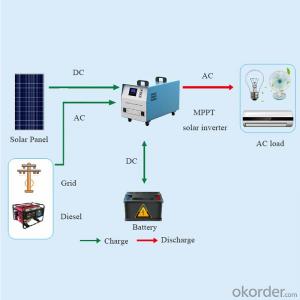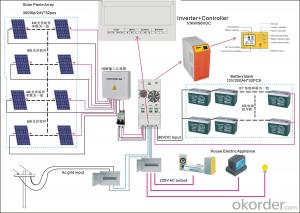Solar energy system 1000W to 5000W for home use
- Loading Port:
- Guangzhou
- Payment Terms:
- TT OR LC
- Min Order Qty:
- 1 set
- Supply Capability:
- 1000 set/month
OKorder Service Pledge
OKorder Financial Service
You Might Also Like
Solar energy system 1000W to 5000W for home use
Features
Solar cell modules
It converts solar energy into electrical energy and the frames support solar panels.
Charge controller
It supplies direct current regulated from solar modules to the battery or inverter.
Stand-Alone Inverter
It supplies alternative current to loads after rectifying the direct current.
Battery
It supplies the electric power to loads through inverter in case the electric power generated from solar modules is in short supply or at night.
Complete 24V/1000W stand alone solar systems
5×200w poly solar panels//1×24V/50A solar charge controller//1×48V/3000W pure sine wave
inverter//4×12V/200Ah lead acid batteries//ground mounting brackets//50m PV cables for solar
panels connection//dual connectors for solar panels connection//connection cables for batteries.
average produce 6kwh power each day!!!
| 12V/200W Poly-crystalline Solar Panels | ||||||||
| Model: 200P Maximum power:200W Maximum power voltage:35V Maximum power current:5.71A Open circuit voltage:42.48V Short circuit current:6.29A Dimension:1350mm×1000mm×45mm Weight: 17.5kg Solar cells:48pieces(6×8)poly solar cells156mm×156mm;Grade A; CE certification Maximum systems voltage: 1000V | 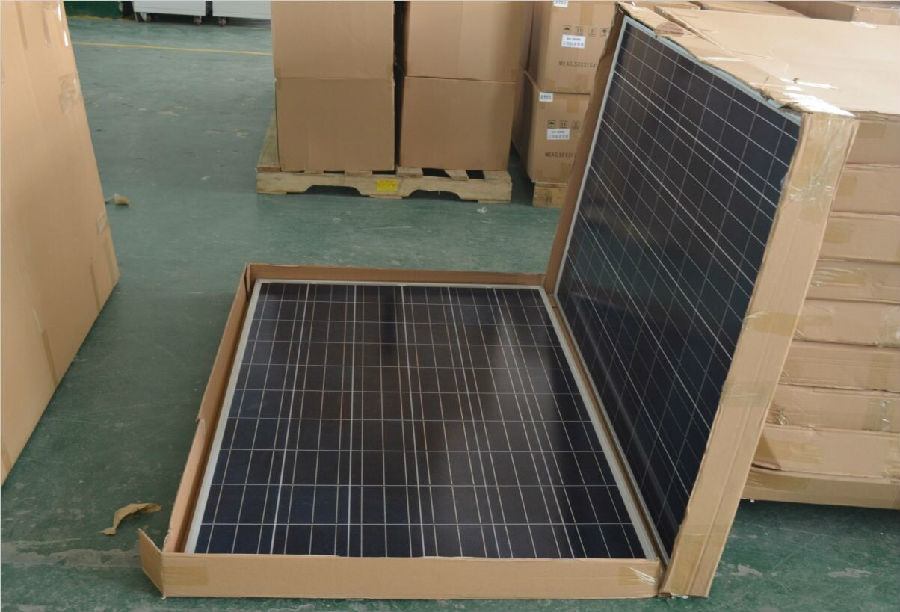 | |||||||
Wiring of solar panels: 1 panels in series, 5 strings in parallel | ||||||||
| 24V/50A solar charge controller | ||||||||
| Model:2450 Rated voltage: 24V Rated current: 50A Over-voltage protection 34V Over-discharge recover voltage: 25V working temperature: -20℃~45℃ Dimension: 184mm×110mm×57mm Weight: 0.66kg Features: battery switch | 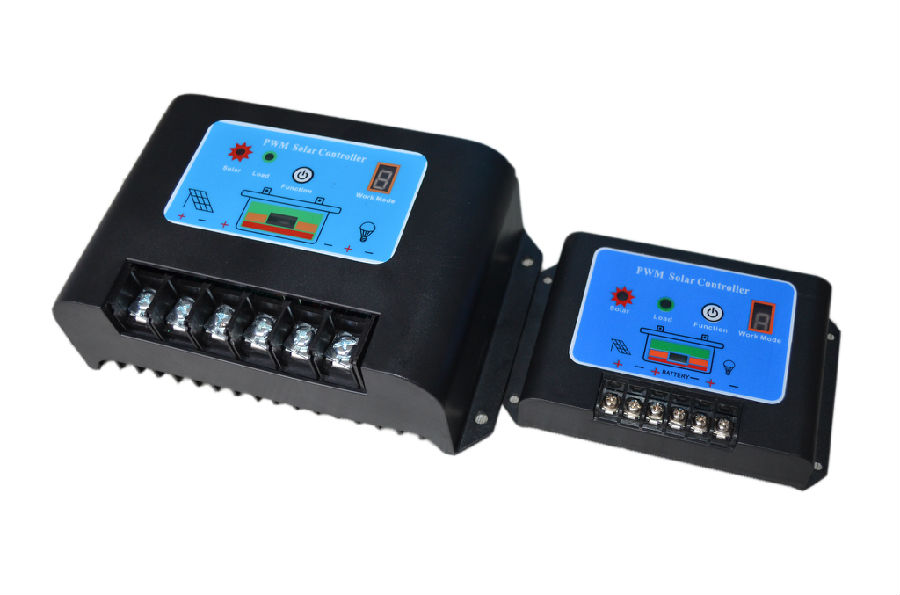 | |||||||
| Wiring of solar charge controller: firstly connect solar charge controller with battery bank, then connect solar charge controller with solar panels array, at last connect solar charge controller with loads or pure sine wave inverter | ||||||||
| 48V/3000W Pure Sine Wave Inverter | ||||||||
| Model:10224 Rated input voltage:DC24V Input voltage range:75V~125V OR 145V~275V Output voltage:AC210V~AC240V Rated output power:1000W Maximum output power:2000W Output wave form: pure sine wave Dimension:396mm×190mm×240mm Weight:14kg. Working temperature: 0℃~40℃. Battery low voltage shutdown: DC21V | 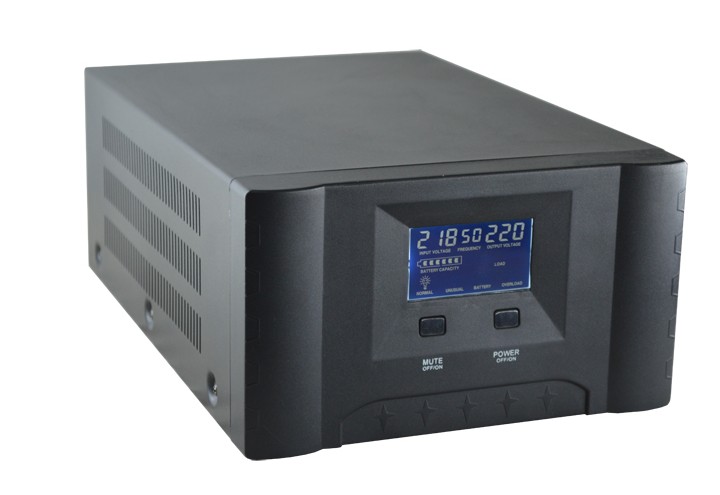 | |||||||
| 12V/200Ah deep cycle battery | ||||||||
| Deep cycle batteries in our stand alone solar systems have 2000 time charging-discharging cycle at 50% DOD. Gel batteries have better performance than lead acid batteries under cold temperature. besides, these battery are free-maintenance. |
| Package&shipment terms | |||||||||
| 1,We would pack all components into one plywood case and put much foam inside of plywood case, this packing way can make all components stand long distance transportation. 2,Because batteries are a kind of very heavy components and can't be allowed to transport by air, we have to choose sea transportation. though sea transportation would take more days to arrive, however you can save much postage. 3.We would ship the system to any bigger port near to customers, customers need to go to the port and pick up the system. |
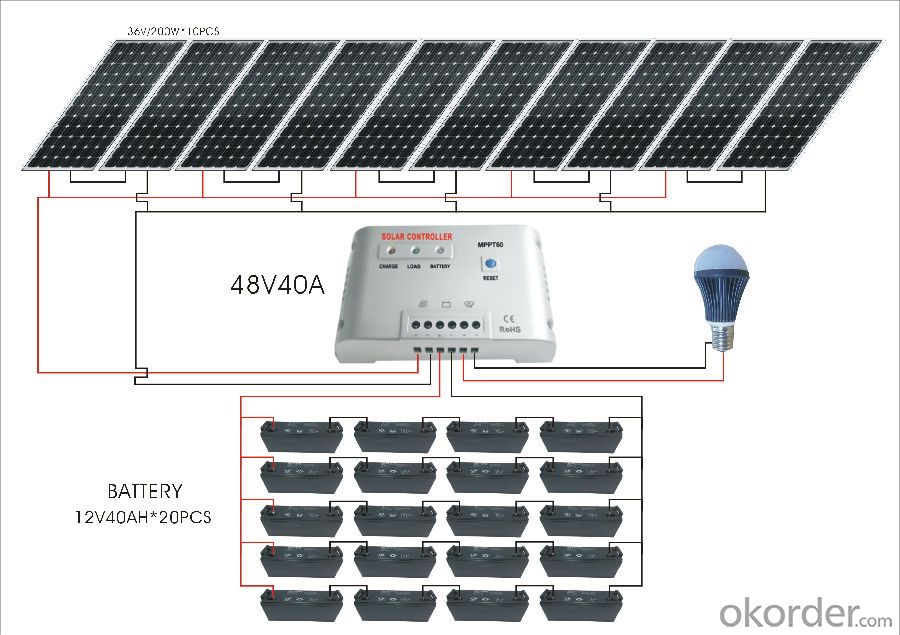
More power system pls contact with me!
- Q: Can solar energy systems be used for desalination or water purification?
- Yes, solar energy systems can definitely be used for desalination or water purification. Solar energy can power various technologies that are employed in the process of desalination and water purification, making it a sustainable and renewable source of energy for these purposes. One of the most common methods of desalination is through the use of solar stills. Solar stills are devices that use the energy from the sun to evaporate water, leaving behind salts, impurities, and contaminants. The steam is then condensed and collected, providing fresh water that is free from salinity and impurities. Solar stills are particularly effective in areas where there is ample sunlight and limited access to freshwater sources. Another method is solar-powered reverse osmosis. Reverse osmosis is a process that uses a membrane to remove salts, impurities, and contaminants from water at high pressure. By utilizing solar energy to power the high-pressure pump, this method can effectively produce fresh water from seawater or brackish water sources. Additionally, solar energy can also be used in combination with other water treatment technologies such as ultraviolet (UV) disinfection and advanced filtration systems. UV disinfection uses the energy from ultraviolet light to kill bacteria, viruses, and other microorganisms present in water. Solar-powered UV disinfection systems are not only environmentally friendly but also cost-effective in areas where electricity supply is limited. In summary, solar energy systems can be harnessed to power various desalination and water purification technologies, providing a sustainable and renewable solution to address water scarcity and improve access to clean water.
- Q: How does the efficiency of solar panels vary across different installation orientations?
- Solar panels can have varying degrees of efficiency depending on their installation orientation. The orientation of a solar panel refers to how it is positioned in relation to the sun's path. There are two main orientations: horizontal, which faces directly upwards, and tilted, which is angled towards the sun. Typically, solar panels that face south have the highest efficiency because they receive the most sunlight throughout the day. This is especially true in the northern hemisphere where the sun is positioned towards the south. South-facing panels are able to capture the maximum amount of sunlight, resulting in optimal energy production. On the other hand, solar panels facing east or west have slightly lower efficiency compared to south-facing panels. East-facing panels receive more sunlight in the morning, while west-facing panels receive more sunlight in the afternoon. However, both orientations receive less overall sunlight than south-facing panels, which leads to reduced efficiency. Among the common orientations, solar panels that are installed horizontally, like those found on flat rooftops, have the lowest efficiency. These panels do not have a specific direction to maximize sunlight absorption and are often less inclined towards the sun's path. As a result, they receive less direct sunlight throughout the day, resulting in lower energy generation compared to tilted or south-facing panels. It's worth noting that the efficiency of solar panels is also influenced by other factors such as shading, climate, and panel quality. Shading caused by nearby buildings, trees, or other obstructions can decrease efficiency by blocking sunlight. Additionally, the climate of a region and the quality of the solar panels themselves can also impact their efficiency. In conclusion, the efficiency of solar panels varies depending on their installation orientation. South-facing panels generally have the highest efficiency, while east, west, and horizontal orientations have lower efficiency levels. Factors like shading, climate, and panel quality also have an impact on the overall efficiency of solar panels.
- Q: Can solar energy systems be used in areas with high altitude?
- Yes, solar energy systems can be used in areas with high altitude. In fact, solar panels can be even more effective in higher altitudes due to the reduced air density, which allows for more direct sunlight to reach the panels. However, it is important to consider the potential challenges such as extreme temperature variations and harsh weather conditions that can impact the efficiency and durability of solar energy systems in high-altitude areas.
- Q: Can solar energy systems be used for outdoor lighting?
- Yes, solar energy systems can be used for outdoor lighting. Solar-powered outdoor lighting systems use solar panels to capture sunlight and convert it into electricity, which is stored in batteries. This stored energy is then used to power outdoor lights during the night. Solar-powered outdoor lighting is a sustainable and cost-effective solution that eliminates the need for traditional electrical wiring and reduces carbon emissions.
- Q: Can solar energy systems be installed on the ground?
- Indeed, ground-mounted solar energy systems are capable of being installed. In fact, they are a favored choice for both residential and commercial purposes. Typically, these systems consist of solar panels affixed to a structure or framework that is securely fastened to the ground. Compared to rooftop installations, ground-mounted systems offer several advantages, including greater flexibility in design, easier accessibility for maintenance and cleaning, and the ability to optimize panel orientation and tilt angle for maximum energy production. Furthermore, ground-mounted systems can be installed in areas with limited roof space or where the roof is unsuitable for solar panel placement. Overall, ground-mounted solar energy systems present a practical and efficient means of harnessing the sun's power for generating electricity.
- Q: Can solar energy systems be installed in areas with high winds?
- Solar energy systems are indeed capable of being installed in areas that experience strong winds. The consideration of wind speeds during the installation of solar panels is vital to guarantee their durability and longevity. These panels are specifically engineered to endure various weather conditions, including gusty winds. By implementing robust mounting systems and utilizing suitable fasteners, their ability to resist wind damage can be further reinforced. Furthermore, certain manufacturers subject their solar panels to rigorous testing procedures to ensure they can withstand high wind speeds. It is highly advisable to seek the guidance of a professional installer who can evaluate the unique conditions of the location and develop a solar energy system that can effectively endure strong winds.
- Q: Can solar energy systems be used for powering refrigeration systems?
- Yes, solar energy systems can be used for powering refrigeration systems. Solar-powered refrigeration systems, known as solar refrigerators or solar coolers, use photovoltaic panels to convert sunlight into electricity which can be used to power the refrigeration process. These systems are commonly used in off-grid areas or remote locations where access to electricity is limited or expensive. They offer a sustainable and environmentally friendly solution for refrigeration needs.
- Q: What is the role of solar energy systems in achieving energy independence?
- Solar energy systems play a crucial role in achieving energy independence by reducing reliance on traditional fossil fuel sources and providing a sustainable and renewable alternative. Solar power systems harness the energy from the sun and convert it into usable electricity, allowing individuals, communities, and even entire countries to generate their own power. One of the main advantages of solar energy systems is their ability to be installed almost anywhere, from residential rooftops to large-scale solar farms. This decentralization of power generation ensures that energy can be produced and consumed locally, reducing the need for long-distance transmission lines and minimizing transmission losses. By generating electricity on-site, solar energy systems contribute to energy independence by eliminating dependence on the grid and the associated costs and vulnerabilities associated with it. Solar energy systems also have a positive environmental impact. Unlike fossil fuels, solar power does not produce harmful emissions or contribute to climate change. By utilizing solar energy, countries can reduce their carbon footprint and work towards meeting their climate goals. Additionally, solar power systems can help reduce the need for environmentally damaging practices such as mining and drilling for fossil fuels. Moreover, solar energy systems contribute to energy independence by providing a stable and predictable source of energy. Unlike fossil fuels, which are subject to price fluctuations and geopolitical tensions, sunlight is readily available and free. By investing in solar energy systems, countries can reduce their vulnerability to energy price shocks and geopolitical dependencies, ensuring a stable and secure energy supply. Furthermore, solar energy systems promote economic growth and job creation. The installation, maintenance, and operation of solar power systems require a skilled workforce, leading to the creation of new jobs and economic opportunities. By investing in solar energy, countries can stimulate their local economies, reduce energy imports, and redirect energy spending towards domestic sources. In conclusion, solar energy systems are essential in achieving energy independence by reducing reliance on fossil fuels, promoting sustainability, offering stable and predictable energy sources, and contributing to economic growth. By embracing solar power, countries can not only secure their energy supply but also contribute to a cleaner and more sustainable future.
- Q: Can a solar energy system power my entire home?
- Yes, a solar energy system has the potential to power your entire home. The size and capacity of the solar energy system will determine its ability to meet your home's energy needs. To determine the appropriate size, factors such as the average daily energy consumption of your household, the available roof or ground space for solar panels, and the amount of sunlight your location receives throughout the year need to be considered. By installing a properly sized solar energy system and using energy-efficient appliances, LED lighting, and energy-saving practices, it is possible to generate enough solar energy to power your entire home and even sell excess electricity back to the grid. It is advisable to consult with a professional solar installer to assess your specific energy requirements and design a solar energy system that meets your needs.
- Q: Are there any ongoing monitoring requirements for solar energy systems?
- Yes, there are ongoing monitoring requirements for solar energy systems. Regular monitoring is necessary to ensure that the system is functioning optimally and generating the expected amount of electricity. This includes checking for any performance issues, such as shading or malfunctions, and monitoring the energy production and consumption. Additionally, monitoring helps identify any potential maintenance or repair needs, ensuring the longevity and efficiency of the solar system.
Send your message to us
Solar energy system 1000W to 5000W for home use
- Loading Port:
- Guangzhou
- Payment Terms:
- TT OR LC
- Min Order Qty:
- 1 set
- Supply Capability:
- 1000 set/month
OKorder Service Pledge
OKorder Financial Service
Similar products
Hot products
Hot Searches
Related keywords
